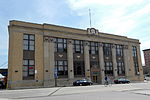Copycat Building

The Copycat Building is a former manufacturing warehouse at 1501 Guilford Ave, Baltimore, Maryland, today used as an artists' studio and living space. Built in 1897, it is home to the city's creative class and a landmark of the Station North Arts and Entertainment District. It earned the nickname "the Copycat" for a billboard advertising the Copy Cat printing company that stood on its roof for years. The building was purchased by Charles Lankford in 1983 for $225,000. At the time it housed a variety of light-industrial tenants, which Lankford sought to retain. During the COVID-19 pandemic, the Copycat Building became a focal point of tenant-landlord conflict. Though state and national eviction moratoria prevented eviction proceedings against tenants, Lankford attempted to remove a number of tenants in arrears by refusing to renew month-to-month leases. Because Lankford operates the Copycat without the legally required licensing, tenants and state legal nonprofits challenged his right to relief in tenant holding over court. In December 2021, the Maryland Court of Appeals ruled in Lankford's favor, allowing him to displace tenants despite lacking a license in a blow tenant advocates have called "an 'earthquake' that could endanger tenants" throughout Maryland.” This ruling led to the passage of the Rental Licensing Accountability Act, which aims to block owners of unlicensed units from seeking relief in specialized tenant courts.
Excerpt from the Wikipedia article Copycat Building (License: CC BY-SA 3.0, Authors, Images).Copycat Building
Jones Falls Expressway, Baltimore
Geographical coordinates (GPS) Address Nearby Places Show on map
Geographical coordinates (GPS)
| Latitude | Longitude |
|---|---|
| N 39.306666666667 ° | E -76.611944444444 ° |
Address
Jones Falls Expressway
21202 Baltimore
Maryland, United States
Open on Google Maps








